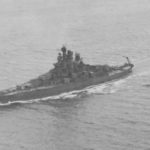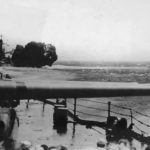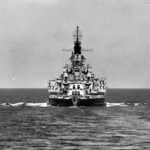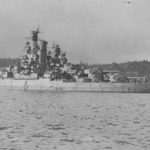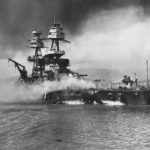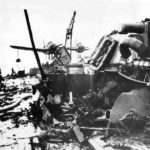Nevada after Japanese Kamikaze attack off Okinawa 25 March1945
USS Nevada underway December 1942
USS Nevada at Norfolk November 1944
USS Nevada firing 14-Inch guns during maneuvers in 1921
USS Nevada stern view
Anchored USS Nevada, Puget Sound December 1942
USS Nevada (BB-36) interwar period
PBY at NAS Ford Island battleship USS Nevada (BB-36) aground in the background
Sailors watch repaired Battleship USS Nevada leave Pearl Harbor 1942
battleship USS Nevada (BB-36) underway during the Pearl Harbor attack
Bofors 40 mm guns of the battleship USS Nevada (BB-36) in action against attacking Japanese planes off Okinawa
battleship Nevada underway during the Pearl Harbor attack 2
Burning USS NEVADA BB-36 during Japanese Attack on Pearl Harbor
USS NEVADA BB-36 after Japanese Kamikaze Attack off Okinawa
Battleship USS Nevada BB-36 Coming Up Hudson River 1944
Starboard view of Battleship USS Nevada BB-36
American Battleship USS Nevada BB-36 bow
American Battleship USS Nevada BB-36
Battleship USS Nevada pulls away burning ship Pearl Harbor
Battleship Nevada (BB-36) was laid down 4 November 1912 by the Fore River Shipbuilding Co., Quincy and launched 11 July 1914. Sponsored by Miss Eleanor Anne Seibert, niece of Governor Tasker L. Oddie of Nevada and descendant of Secretary of the Navy Benjamin Stoddert; and commissioned 11 March 1916, Capt. William S. Sims in command.
Nevada joined the Atlantic Fleet at Newport 26 May 1916 and operated along the east coast and in the Caribbean until World War I. After training gunners out of Norfolk, she sailed 13 August 1918 to serve with the British Grand Fleet, arriving Bantry Bay, Ireland 23 August. She made a sweep through the North Sea and escorted transport George Washington, President Woodrow Wilson embarked, during the last day of her passage into Brest, France, before sailing for home 14 December.
Nevada served in both Atlantic and Pacific Fleets in the period between the wars. In September 1922 she represented the United States in Rio de Janeiro for the Centennial of Brazilian Independence. From July to September 1925, she participated in the U.S. Fleet’s goodwill cruise to Australia and New Zealand, which demonstrated Japanese ability to make a self-supported cruise to a distance equal to that to Japan. Modernized at Norfolk Naval Shipyard between August 1927 and January 1930, Nevada served in the Pacific Fleet for the next decade.
On 7 December 1941, Nevada was moored singly off Ford Island, and had a freedom of maneuver denied the other 8 battleships present during the attack. As her gunners opened fire and her engineers got up steam, she was struck by one torpedo and two, possibly three, bombs from the Japanese bombers, but was able to get underway. While attempting to leave harbor battleship was struck again. Fearing she might sink in the channel, blocking it, she was beached at Hospital Point. Gutted forward, she lost 50 killed and 109 wounded. Refloated 12 February 1942, Nevada repaired at Pearl Harbor and Puget Sound Navy Yard, then sailed for Alaska where she provided fire support for the capture of Attu 11 to 18 May. In June she sailed for further modernization at Norfolk Navy Yard, and in April 1944 reached British waters to prepare for the Normandy Invasion. In action from 6 to 17 June, and again 25 June, her guns pounded not only permanent shore defenses on the Cherbourg Peninsula,
but ranged as far as 17 miles inland, breaking up German concentrations and counterattacks. Shore batteries straddled her 27 times, but failed to diminish her accurate fire. Between 15 August and 25 September, Nevada fired in the invasion of Southern France, dueling at Toulon with shore batteries of 340 mm guns taken from French battleships scuttled early in the war. Her gun barrels were relined at New York, and she sailed for the Pacific, arriving off Iwo Jima 16 February 1945 to give marines invading and fighting ashore her gunfire support through 7 March. On 24 March, Nevada massed off Okinawa with the mightiest naval force ever seen in the Pacific, as pre-invasion bombardment began. She pounded Japanese airfields, shore defenses, supply dumps, and troop concentrations through the crucial operation, although 11 men were killed and a main battery turret damaged when she was struck by a suicide plane 27 March. Another 2 men were lost to fire from a shore battery 5 April. Serving off Okinawa until 30 June, from 10 July to 7 August she ranged with the 3rd Fleet which not only bombed the Japanese home islands, but came within range for Nevada’s guns during the closing days of the war. Returning to Pearl Harbor after a brief occupation duty in Tokyo Bay, Nevada was surveyed and assigned as a target
ship for the Bikini atomic experiments. The tough old veteran survived the atom-bomb test of July 1946, returned to Pearl Harbor to decommission 29 August, and was sunk by gunfire and aerial torpedoes off Hawaii 31 July 1948. Nevada received 7 battle stars for World War II service.
Nevada-class battleships.
Laid down: 4 November 1912
Launched: 11 July 1914
Commissioned: 11 March 1916
Main armament: 10 x 356 mm L/45
Fate: Sunk as a practice gunnery target 31 July 1948
Bibliography:
- Navy Department, Office of the Chief of Naval Operations, Naval History Division: Dictionary of American Naval Fighting Ships, Volume IV
- US Standard-type Battleships 1941-1945 (1): Nevada, Pennsylvania and New Mexico Classes – Osprey New Vanguard 220
- U.S. Battleships in Action, Part 1 – Robert C. Stern, Don Greer; Squadron/Signal Publications Warships No. 3
- U.S. Battleships: An Illustrated Design History – Norman Friedman; Naval Institute Press 1985
- The Age of the Battleship 1890-1922
- US Navy Dreadnoughts 1914-45 – Osprey New Vanguard 208
- Battleships The First Big Guns, Rare Photographs from Wartime Archives (Images of War) – Philip Kaplan
- Battleships – Peter Hore; Lorenz Books 2005
- Battleships: United States Battleships, 1935-1992 – Naval Institute Press 1995
- Battleships: An Illustrated History of Their Impact – Stanley Sandler
- All the World’s Battleships: 1906 to the Present – Ian Sturton; Conway Maritime Press 2000
- Pacific Crucible: War at Sea in the Pacific, 1941-1942 – Ian W. Toll
- Pearl Harbor Story: Authentic Information and Pictures of the Attack on Pearl Harbor, December 7, 1941 – Swak Inc 1974
- Air Raid: Pearl Harbor! The Story of December 7, 1941 – Theodore Taylor
- One Day in History: December 7, 1941 – Rodney P. Carlisle
- Pearl Harbor 1941: The Day of Infamy – Carl Smith; Osprey Campaign 62
- Tora! Tora! Tora! Pearl Harbor 1941 – Mark E. Stille Osprey Raid 26
- The Attack on Pearl Harbor: The United States Enters World War II – Chelsea House Publications 2008
- The Attack on Pearl Harbor: Strategy, Combat, Myths, Deceptions – lan Zimm
- Pearl Harbor: The Seeds and Fruits of Infamy – Percy L. Greaves Jr.

